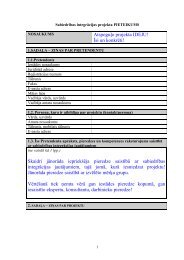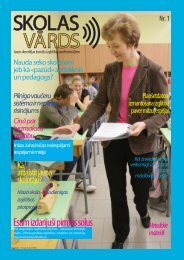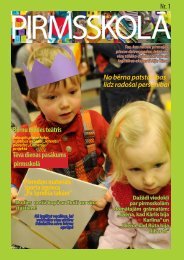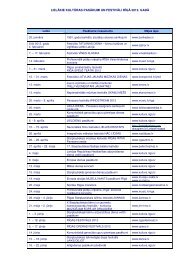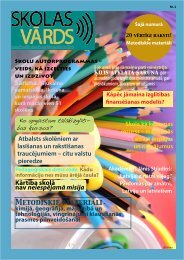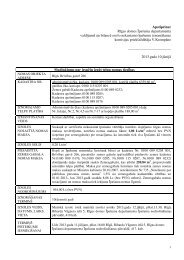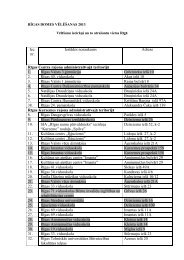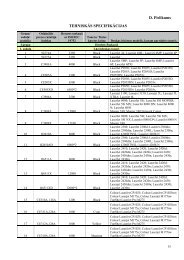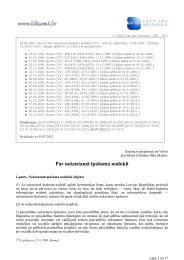Riga - European Capital of Culture 2014 candidate
Riga - European Capital of Culture 2014 candidate
Riga - European Capital of Culture 2014 candidate
- No tags were found...
Create successful ePaper yourself
Turn your PDF publications into a flip-book with our unique Google optimized e-Paper software.
the book, 1514-<strong>2014</strong>Massys, Quentin. Der Goldwäger und seine Frau. (1514)‘I stare at the textual field on my friend’s screen and I am unpersuaded.Indeed, this glimpse <strong>of</strong> the future–if it is the future–has me clinging all the more tightly to my books, the very idea<strong>of</strong> them. If I ever took them for granted, I do no longer. I nowsee each one as a portable enclosure, a place I can repair to torelease the private, unsocialized, dreaming self. A book is solitude,privacy; it is a way <strong>of</strong> holding the self apart from the crush<strong>of</strong> the outer world. Hypertext – at least the spirit <strong>of</strong> hypertext,which I see as the spirit <strong>of</strong> the times – promises to deliver mefrom this, to free me from the ‘liberating domination‘ <strong>of</strong> the author.It promises to spring me from the univocal linearity whichis precisely the constraint that fills me with a sense <strong>of</strong> possibilityas I read my way across fixed acres <strong>of</strong> print.‘Sven Birkerts, The Gutenberg ElegiesThe opening <strong>of</strong> the new Latvian National Library building isplanned for 2013. It will be more than just a significant <strong>European</strong>cultural event in architecture – <strong>Riga</strong> will be the <strong>European</strong> bookcapital in <strong>2014</strong>. After moving to its new premises, the LatvianNational Library is going to organise a large-scale book exhibit“The Book 1514-20014“ (Grāmata 1514-<strong>2014</strong>), dedicated tohumanity’s history in reading over the past 500 years. Manyunique books will be brought to <strong>Riga</strong>. An international conference“The Content <strong>of</strong> the 21 st Century” is also planned. SvenBirkerts – the American writer and literary critic – has been invitedto be the patron <strong>of</strong> the conference. He happens to be the son <strong>of</strong>the architect <strong>of</strong> the most significant building to be built in <strong>Riga</strong> inthe years since the restoration <strong>of</strong> independence - the new NationalLibrary. The theme <strong>of</strong> the conference will be the history <strong>of</strong> reading.Among the participants expected are the Nobel Prize laureatesin literature V .S. Naipaul and Imre Kertész; Harold Bloom, one <strong>of</strong>the world’s leading literature critics; the linguist Noam Chomsky;the philosopher Alexander Piatigorsky; the writers Umberto Eco,Tatyana Tolstaya, Václav Havel, and Jānis Krēsliņš; the founders<strong>of</strong> Google, Larry Page and Sergey Brin, and other luminaries.The conference will take place at the same time as the opening <strong>of</strong>the exhibit “The Book” 1514-<strong>2014</strong>1514 is unique in the history <strong>of</strong> the <strong>European</strong> book. It is the agewhen the printed book has already stepped out <strong>of</strong> its cradle(incunabula in Latin). The next era has begun with its brightestsigns – the high Renaissance and the Reformation. The bookloses the features <strong>of</strong> a manuscript and new traditions in printingand publishing emerge – it is the time <strong>of</strong> the appearance <strong>of</strong> titlepages, illustrations (engravings), printed works in local languages,printed music scores, etc. 1514 is the very special year that marksthe border between the passing and the coming ages.Hartmann Schedel – the author <strong>of</strong> the “World Chronicle” (1493) –dies in 1514. Notably, it is in this year that the Abbot <strong>of</strong> TrittenheimJohannes Heidenberg publishes his inventory <strong>of</strong> books printedsince Gutenberg’s invention came about, abate Tritemioscrive la Cronaca Irsaugense che reca importanti precisazionisull’invenzione di Gutenberg. This year brings forth several outstandingworks by his contemporaries. At least six (!) books byErasmus <strong>of</strong> Rotterdam are published (Parabolarum and others).It is very likely that the manuscript <strong>of</strong> Till Eulenspiegel was beingprepared by a typesetter to be printed in the following year.Also in the year 1514, Copernicus mentions his work on developingthe description <strong>of</strong> heliocentric system in the manuscript“Small Commentaries” (Commentariolus) that he distributes to hisfriends. Several engravings by the distinguished Albrecht Dürerappear (Melencolia I, Der heilige Hieronymus im Gehäus). Thebooks <strong>of</strong> John Rastell also should be mentioned, as well as thepapal bull <strong>of</strong> Leo X (1475—1521) and the letter <strong>of</strong> England’s KingHenry VIII to the Pope.The range <strong>of</strong> books in 1514 includes classics (at least nine worksby Cicero, three by Ovid, five by Plautus, two by Pliny, four byVirgil, as well as works by Aristotle, Horace, Plutarch, Ptolemyand Seneca), the famous Biblia Poliglota, and Avicenna’s Florescollecti superquinque Canonibus quos adidit in medicina (Lyons)as well as works by the Renaissance master Boccaccio and byJoannes Eckius (Johann Eck) – the future ardent antagonist <strong>of</strong>Martin Luther – who writes about the coming years. This is one<strong>of</strong> the brightest years in the era’s art <strong>of</strong> printing. 1514 sees the appearance<strong>of</strong> books printed by Aldus Manutius (1449/1450—1515)in Venice (Scriptores rei rusticae), the Athenaeus <strong>of</strong> Philippus andLucas Antonius Giunta in Florence, Cicero’s letters to Atticam,Johann Froben (c. 1460—1527) sheltered and published Erasmus38 39



